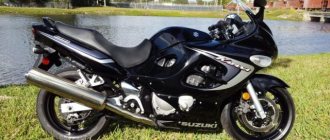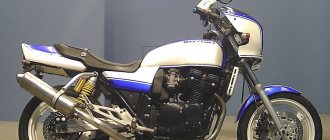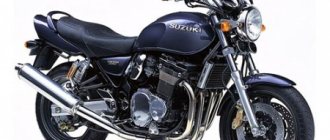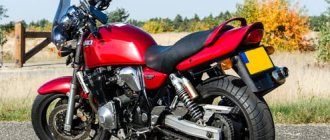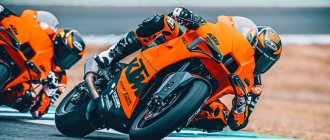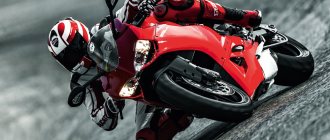The legendary Suzuki GSX R-750 has been shaking roads around the world since the mid-80s. It was then that the Suzuki company took an unprecedented step by releasing civilian sportbike, developed on the basis of racing motorcycles. At that time, championships were still held in the capacity of up to 750cc, so other Japanese companies took up the initiative. Competition forced Suzuki to continue to develop the model, and now the Jixer is the only one of its kind, because all other participants dropped out of the race after the cancellation of the world championships in 750 cc.
Design
Since the release of the first GSX750R, the model has already gone through a dozen restylings, but each generation of the motorcycle corresponded to the spirit of its time. The first copies look alien in modern realities, but the latest generations were designed by leading designers, and they look great. The generation currently in production was released in 2011, and we can expect another update in the coming years. There have been no significant design changes since 2007, when the GSX R 750 K7 was released.
Specifications
In modern realities, the GSXR 750 remains the only intermediate-sized sportbike, although there are classics and streetfighters with similar technical characteristics. But both them and the Suzuki sportbike can only be recommended for fairly experienced pilots . High power requires honed skills, a cool head and responsibility. However, the Suzuki GSX 750's technical characteristics are generally well balanced, so you can quickly get used to the bike.
Engine
The first Jixer engines used air-oil cooling, but it was decided long ago to abandon it in favor of liquid cooling. In 2008, the S-DMS (Suzuki Drive Mode Selector) system appeared as an additional option, allowing you to choose from three engine operating modes. On the last two generations, the 749 cc 16-valve engine produces 150 hp. power and 86.3 Nm of torque available at 11,200 rpm . The maximum speed of the GSX 750 reaches 280 km/h , and it accelerates from 0 to 100 km/h in 3.08 seconds .
Transmission
The six-speed transmission has undergone many changes over the past decades. It works properly, a little rough, but it's easy to get used to after a few days of driving. But it is trouble-free, problems with it are extremely rare. The efficiency of the transmission has increased even more since 2006, when, along with the new engine, the sportbike received a slipper clutch.
Chassis and brakes
"Jixers" have always been equipped with light alloy frames , which reduced the weight of the motorcycle. The latest generation Suzuki GSX R750 has a curb weight of only 190 kg , and a dry weight of even less, and this is an excellent indicator. The brakes are also decent, especially since 2008 when Japanese engineers began installing the new Brembo braking system . Early examples had problems with the effectiveness of the brakes - there were objectively not enough of them on the track, but this is far in the past. As well as rigid suspensions, since the Suzuki GSX 750 has long acquired a fully customizable chassis, which can be easily adjusted in garage conditions. The last update took place in 2011, when, along with a new Showa fork, the sportbike received a new frame with a pendulum.
Electronics
The latest generations of Suzuki bikes have become noticeably more technically complex. For full diagnostics, you need to connect a laptop with special software to the motorcycle via a bus, which is available only from dealers. But the old “Jixers” are equipped with a minimal amount of electronic filling, and any motor electrician can easily understand them.
Weight and dimensions
Suzuki engineers managed to achieve their goal and reduce the weight of the motorcycle to a virtual minimum. The Suzuki GSX 750 weighs comparable to the 600 and has similar dimensions, while possessing the dynamics of a “liter” sportbike. This provides it with significant advantages both in the city and on the track, and this is why the GSX-R 750 is loved by hundreds of thousands of bikers.
Controllability
Having ridden a fresh Suzuki GSX 750, you understand that you won’t be able to find fault with its handling. The bike behaves so predictably on the road, and so obediently does everything the pilot wants, that it can be called a standard in this parameter. But the same cannot be said about the “Jixers” of the 90s - they had their own problems, such as a tendency to wobble and mediocre feedback from the front wheel, especially on roads with poor-quality surfaces.
Fuel consumption
The motorcycle has been equipped with fuel injection since 1998, and the introduction of a fuel injection system has reduced fuel consumption. On modern Suzuki GSXR 750 it averages just under 6 liters per hundred , although there is practically no upper limit - with aggressive driving, consumption increases rapidly . Old carburetor models are noticeably more voracious, and consume 1-1.5 liters more, while at least preferring AI-95. Although some owners of old “Jixers” fill it with AI-92, and, according to reviews, the motorcycles digest it normally.
General description of the latest version
The last significant innovations affected the model in 2010. The motorbike received a more advanced motor and advanced electronics. It is impossible not to note the real revolution of that time: the ability to select the engine operating mode, a suspension with many settings, as well as a slipper clutch. The new product is based on an aluminum diagonal frame. The car retains the same excellent handling, so the pilot can be confident in it, regardless of driving conditions. Thanks to the suspension customization function, the rider and the motorcycle become one. The total weight of the new product in running order is 190 kilograms, while the dimensions, respectively, in length, width and height are 2030x710x1135 millimeters.
Repair and tuning
Owners of the GSX-R 750 will be pleased with the fact that there are enough spare parts for their steel horses. There are both original Suzuki parts on sale and a lot of analogues, which are often not inferior in quality to components sold by official dealers.
Repair
Maintaining old Jixers yourself is not difficult. In recent generations, Suzuki engineers have significantly improved the design, at the same time making it more complex, so for a number of issues you will have to contact authorized dealers. But this trend affects all modern motorcycles and cars.
Spare parts
The selection of spare parts is very large, although the necessary parts are often not available. The problem can be solved by ordering from foreign online stores. This will save your budget, but you will have to wait for delivery, which may take a month or two. Modern Suzuki GSX 750s cost about the same amount to maintain as the old ones.
Tuning
Probably no sportbike in the world has as much tuning as the Suzuki GSX-R750. This is doubly true for previous generations, which were notorious for insufficiently effective brakes with sluggish feedback. Therefore, many sportbikes of this model on the secondary market are sold in a form modified by previous owners, with reinforced brake hoses, new brake cylinders and calipers.
What else can there be to say about the GSX-S750?
The motorcycle is “not greedy”. The capacity makes it very flexible. You don't have to think about the lack of fuel, and my combustion came out at 6.48l/100km. In traffic jams he gives advice. It has a fairly large, well hidden storage area. It is well defined by legs that are not supported by any frames or plastic bends. Transparent and clean dial with clearly visible speed indicator, large gear indicator. Of course, the turnover, according to the trend, is represented by a belt. The switches are cool and duplicated. What we present on the display can be controlled not only by the buttons under the watch, but also by the thumb on the steering wheel. And the pendant gives advice. The city is right. The larger the holes, the worse, but, as a rule, there is nothing to attach. Unfortunately, I don't know about riding with a passenger on this bike, but it looks like it.
Suzuki GSX-S750
Suzuki GSX-S750
Suzuki GSX-S750
Suzuki GSX-S750
Suzuki GSX-S750
Motorcycle modifications
The first GSX R 750 was a racing bike slightly adapted for public roads. Engineers equipped it with the latest technology - an aluminum frame, powerful brakes with 4-piston calipers, an anti-dive system and much more, which in 1985 was a real innovation. Since then, the sportbike has been continuously improved and refined, but several main milestones can be identified, before and after which the motorcycle is very different:
- 1989. Release of a single-seat racing modification of the GSX-R750R with a retuned engine and all the improvements available at that time.
- 1990. The appearance of an inverted fork instead of the usual “telescope”.
- 1992. Completely new liquid-cooled engine with increased torque and power.
- 1996. Introduction of the Suzuki Ram Air Direct (SRAD) inertial charging system and the appearance of settings for the front fork of the motorcycle. Instances of the next model year were named Suzuki GSX R 750 SRAD.
- 1998. Replacing Mikuni carburetors with an injector, increasing the maximum engine power.
- 2000. Deep reworking of the Suzuki Jixer 750 motorcycle - new wheels, frame, plastic, brakes, exhaust and injector.
- 2004. Generation K4 – modified engine with titanium valves and increased to 147 hp. power, as well as a completely new design.
- 2006. The all-new GSX 750 K6 arrives, with a new frame, transmission and engine.
- 2008. With the release of the GSX 750 K8, the Drive Mode Selector system with three available engine operating modes is introduced for the first time. This is the only difference from the GSX R 750 K7, which went into production a year earlier.
- 2009. The latest generation of “K”, in this case – K9. All newer copies receive the letter L in the name.
- 2011. Weight reduction thanks to a redesigned frame and swingarm, plus a new Showa fork.
Review of Suzuki GSX-R750 1998
The problem with those who break into the first numbers is that you instantly turn into a target. Now you are a target for everyone, and it is quite difficult to constantly repel all the attacks of your opponents. Staying on top requires continuous improvement to keep you from becoming a fixed target in your opponents' crosshairs.
GSX-R750 sportbike into the 750cc class in 1996 , it wasn't hard for Suzuki to just sit back all year and watch others try to catch up. And why not? After all, the GSX-R is so much lighter, faster and smarter than its closest competitors that refusing to make any changes could be seen as an act of mercy towards others. They could just resort to BNG ("bold new graphics" - new paint and color schemes), maybe changing minor details, and call it another win. Unfortunately (for competitors at least) the word "complacency" doesn't seem to be part of Suzuki's vocabulary these days.
When Suzuki US representatives explained to the Japanese how happy they were to see the capabilities of the '96 GSX-R during preliminary testing, the response from the factory experts was: "Wait until you see the latest version in a year or two." She's even better." What was it? How can they possibly improve on a bike that has set new standards not only in the 750 class, but throughout the sportbike world? Replacing carburetors with electronic fuel delivery may be a good place to start.
While last year's GSX-R featured a traditional steering damper on the left side of the frame crossbar (right), in the '98 EFI model Suzuki installed the damper under the steering head (left)
While EFI (Electronic Fuel Injection) is nothing new on today's sportbikes, Suzuki's new EFI GSX-R750 represents the first modern, mass-produced (sorry, Bimota purists) engine with four cylinders lined up. “Today's sport bikes have almost reached the limits of carburetors in terms of performance versus emissions,” says Suzuki spokesman Mark Rees. Government agencies under the Environmental Protection Agency (EPA) are increasingly placing restrictions on unwanted emissions byproducts. Trying to accurately measure enough fuel to produce power while still burning it cleanly is becoming more difficult than ever before. Injecting atomized fuel into the intake path through an injector, rather than relying on the laws of physics to deliver fuel through a miniature orifice as in antique carburetors, makes it much easier for engineers to control the mixture.
Fuel injection allowed Suzuki to get rid of 30 mm carburetors in favor of throttle bodies with 46 mm throats, as well as increase the volume of the air box from 9.5 to 10 liters, and increase the air intake cross-sectional area by 50%. This also allowed the intake camshaft to be raised, extending the duration of the intake and exhaust valves, another step in increasing power. And all this without increasing emissions. This is one of those rare occasions when we not only have our cake, but we can eat it too. (Unfortunately, California motorcyclists may not be able to take advantage of these new features due to stricter emissions laws.)
The GSX-R still uses threaded bushings to adjust spring preload, but turning the bushing with a hammer and punch is much easier in the new EFI model than in previous years.
The exhaust system has also been modified to improve low- and mid-range torque. The length of the main tube was reduced by 20 mm, the collector tubes became smaller in diameter by 1.4 mm. A side effect of these changes was a slight reduction in the overall weight of the exhaust system. Using the same EFI system found on the V2 TL1000S, the single injector per cylinder unit in the GSX-R implements a two-step fuel flow control scheme. At low and medium speeds, as well as under light load, the system calculates the injection duration (time, in flow during which the injector directs fuel into the intake port) based primarily on suction pressure and engine speed. Because engine intake pulses at low rpm can be very variable, using intake pressure to measure fuel flow provides more accurate results than using throttle position. As soon as the rider begins to pull on the throttle cable, the system begins to make its decision based on data received from the throttle position sensor and the engine speed indicator. The engine control module (ECM), which controls injection timing, ignition timing and fuel pump operation, not only receives information from the above sensors, but also checks data from sensors measuring engine coolant temperature, intake air temperature, atmospheric pressure and crankshaft and camshaft position . Something like Erv Kanemoto riding next to you and keeping the engine running smoothly. (It also looks like you can install a new muffler without requiring magic "chips").
The front end is largely the same on the EFI model, except the fork gets stiffer springs and a rebound damper. Additionally, the brake rotors are thicker (5.0mm instead of 4.5mm) to improve abrasion resistance. New discs with less offset rotor pins increase the weight slightly.
The engine itself has also undergone some updates. As part of the previous philosophy, which required removing weight wherever possible, changes were made such as reducing the engine primary gear (minus 40 grams), installing more “refined” bolts (such as those used on the GSX-R600, which allowed reducing weight by 200 grams), and direct digital spark plug caps (again, like those on the GSX-R600, and saving 400 grams in weight). A smaller 525-size drive chain replaced the previous 530-size chain, and gear ratios were moved closer together from first to fifth speed, which, along with the engine's reduced primary gearing, improved acceleration. The chassis and chassis did not remain unchanged. The frame has been strengthened in the rear suspension area, while the swing arm pivot section is stronger and 320 grams lighter by switching from an earth-mold casting to a low-pressure casting process. Although the front brake rotors became heavier due to an increase in thickness (from 4.5 mm to 5.0 mm), this was partially offset by a reduction in the number of rotor floating pins from 10 to eight. Both the front and rear suspensions feature revised (read: stiffer) springs and dampers, with a unique "temperature compensation" system built into the rear shock damping components. When oil density decreases due to the heat that accompanies high loads (such as during racing), this heat causes the aluminum shaft to expand, allowing the valve needle to sink further into its bore. This restricts oil movement, which in turn increases the stiffness of the rebound damper. Tricky, right? We can thank our mud-splattered brethren on the racetrack for this part, borrowed from Suzuki's RM motocrossers.
The solenoid-controlled "slamming" intake valve in the air box is said to maintain the desired airflow rate, providing better power at low engine speeds, although it probably has as much to do with controlling intake noise as it does with airflow.
The first thing you notice when you sit in the new GSX-R's normal street driving position is that you can now actually see the tachometer without having to try to see it through the windshield like last year's model. Suzuki has increased the windshield bubble angle slightly, which also helps a bit with wind protection, although the rider's upper torso still takes the brunt of the wind pressure.
Like any fuel-injected motorcycle, the EFI 750 starts instantly on a cold morning. The throttle lever actually provides a brief period of idle. The GSX-R can get moving within just 30 seconds of warming up. Once you get going, you'll notice that other characteristics of the previous GSX-R have largely disappeared: the revs drop and rise with slight changes in throttle position due to the EPA-mandated lean fuel mixture for the carbureted version. The new GSX-R also performs satisfactorily at both 4,000 rpm in city street traffic and 13,000 rpm with the throttle wide open. Unfortunately, the excessive drive chain slack of previous years continues in the new Suzuki, and together with the precise throttle response in the fuel injection system, leads to jerking, and can cause a real headache from constant throttle changes.
Another new feature this year is a steering column damper mounted under a triple clamp, which unfortunately requires more effort when steering on narrow city roads.
Comparison with the '96 model shows that the '98 model has a higher "bubble" providing increased wind protection. It also allows the instrument panel to be seen more clearly in a clear position, rather than forcing the rider to peer through the windshield.
Of course, the rider is happiest when the engine howls at 13,000 rpm. Make no mistake, and if you're more concerned about overall comfort and highway performance, then don't choose this bike. There is no time to discuss the basic characteristics of engine design: a high-revving engine with a piston stroke less than the cylinder bore requires some experience from the rider to keep the speed in the upper part of the power band. The Suzuki's airbox features a "slamming valve" that is said to restrict airflow at low rpm (and maintain air intake speed) to provide better low-end grunt. But when compared to any other 750, the word “grunt” is better replaced with “whine.” However, mid-range acceleration is slightly improved, with the fuel-injected GSX-R quicker than the carbureted model at both 60-80 mph (96-128 km/h) and 80-100 mph (128-160 km/h). km/h) on the run-in test, ahead of him by more than half a second. But we attribute this to first gear and the gearbox's closer ratios rather than fuel injection. Of course, it's not a Bandit 1200, but it's still better than nothing.
This year, the GSX-R's rear body has been widened slightly and slots have been added to accommodate a U-lock. There is now enough space to accommodate small essential luggage.
Since the overall chassis and all moving parts remain relatively unchanged, the GSX-R750 is still capable of handling twisty roads. The close-ratio gearbox makes it easier to keep the engine at a stable rpm, while the need to carefully change gears during city driving when the road gets worse is simply eliminated. Sharp cornering response allows you to point the bike wherever you want when turning, and the new Dunlop D207 Sportmaxes are a far cry from the merely adequate D202s they replaced. These tires provide excellent traction and steering. Pay attention to the gear selection on very twisty sections, it's somehow hard to argue with 115.7 horsepower pushing a 400-pound (181 kg) car.
The cylinder block has a "closed deck" design on its top surface. By reducing the number of coolant passages that weaken structural integrity, the pistons can fit more tightly to the cylinders, theoretically resulting in more power.
It may be due to a combination of staggered gear ratios and more precise fuel delivery through the injectors, but the new GSX-R is noticeably quicker around corners. Part of this may be due to the more user-friendly powerband, which allows for higher speeds and easier throttle opening in corners than what the carbureted version delivers at 9,500 rpm. The new GSX-R transitions more smoothly from supersonic to extreme speeds. While heavier riders may notice changes in suspension damping and spring rates while riding off-road, these improvements are more noticeable when the bike is on the track. Instead of increasing the rebound damper stiffness to the maximum (and wanting to increase it even more) as we did last year, we discovered that we could do it differently. Approximately 3/4 of a turn from the maximum position on the rear damper and one turn from the maximum on the forks turns out to be optimal this time. And the use of Michelin's ultra-grip Hi-Sport Race 3 radials gave us a confident ride, further highlighting Suzuki's continued prowess on the circuit. We've been singing the GSX-R's praises since its introduction, so suffice it to say that the new suspension keeps the chassis much more composed in areas where heavy loads are involved. It's no surprise that most of the bikes racing in club racing these days are GSX-R750s. The use of electronic fuel injection control allowed Suzuki engineers to play a number of tricks with this engine without the risk of increasing emissions.
If you intend to drag race the new GSX-R, then stock up on friction clutch discs. Our rims started smoking after just three laps, and the same fate befell the Motorcyclist test group. This is one of the prices we have to pay for the manufacturer's zealous desire to save every possible gram of weight. Suzuki could have left the GSX-R750 unchanged for '98 and still be the leader in the 0.75-liter class. But by equipping the new model with fuel injection and making many other changes, the company has stepped even further from its competitors. The new GSX-R features a unique heat compensation system that uses a needle valve to adjust the cross-sectional area in the rebound damper duct. This idea is borrowed from the company's RM series motocross motorcycles.
Opinions:
So the question is: is the best one better than others? And the answer to this question is: not really. Then we can pose the question differently: Should it be the best? The answer to this is: perhaps not. All this leads us to another question: So is it the best? To this question I will say that it should have been asked. And then I would say much of what is written below. The result is the result.
Suzuki made two important changes to the '98 GSX-R750 - changing the suspension alignment and adding fuel injection (electronically controlled).
If you have a Princess and the Pea sensibility in your crotch, you'll notice a difference in the suspension. The one percent of our racing readers will appreciate the suspension changes as they all try to tighten things up to the limit.
On the EFI front, the bike gains more power in the mid-range, although this has more to do with the increased torque and lower gearing than anything else.
However, EFI also has its disadvantages. Turning the throttle after it has been fully closed causes the motorcycle to bounce as if the throttle were being operated manually. The new bike also has a steering column damper, which some people find too stiff at low speeds, but this can be fixed with a wrench, so you can throw it away and not have to worry about it. You can also rub some mint on it and give it to your kitty. Have I ever told you about my cat named Bob? The bottom line is that the GSX-R750 is still the crackiest. - Jackson
Many of you may be wondering why so much attention is paid to fuel injection when the power charts show that it does not increase peak power and what is achieved in the mid-range can be neglected. How about this: no adjustments required when installing a new muffler, instantly increasing power by seven horsepower, and the ability to make future exhaust changes by simply plugging in a laptop and pressing a few buttons on the keyboard? And all this for a very small increase in price.
Of course, I expected a greater increase in power when adding EFI to the GSX-R. But while I was initially disappointed, after looking at the power charts, I only had to ride the bike to see otherwise. It's impossible to ride the power chart. And in the real world of rough road surfaces, the GSX-R has its advantages. The rest of the bike may have remained unchanged, but who said they were needed? The GSX-R is still a confidence-inspiring motorcycle. Its excellent front-end response and strong, short chassis make it easier to turn in, brake later, and turn the steering wheel at the last possible moment. Yes, its engine requires constant attention from the rider during tight turns, but this is precisely one of those aspects that makes sports riding fun - a constant challenge to improve your skills. So no matter how you cook it, the song remains the same: the GSX-R slices. - Ralf.
Technical specifications Suzuki GSX-R750 1998 | |
| Engine: | Liquid-cooled, transverse, 4 cylinders in line, 4-stroke |
| Valve location: | DOHC, 4 valves per cylinder |
| Engine capacity: | 749 cm3 |
| Bore and stroke: | 72.0 x 46.0 mm |
| Compression Ratio: | 11.8:1 |
| Carburation: | Mikuni/Denso fuel injection. 46mm throttle |
| Transmission: | 6 speeds |
| Front suspension: | 43mm Showa reverse fork, 6.7mm travel, adjustable spring preload and rebound damper |
| Rear suspension: | Single Showa damper, 5.2mm travel, adjustable spring preload compression and rebound damper |
| Front brake: | 2 calipers with 6 pistons, 320 mm discs |
| Rear brake: | Clip with 2 pistons, 220 mm disc |
| Front wheel: | 3.50 x 17 inches (88 by 431 mm), cast aluminum |
| Rear wheel: | 6.00 x 17 inches (152 by 431 mm), cast aluminum |
| Steering Column Tilt/Track: | 24.0 degrees/3.8 inches (96 mm) |
| Wheelbase: | 55.1 inches (1400 mm) |
| Seat height: | 32.7 inches (830 mm) |
| Fuel tank capacity: | 4.7 gal (18 l) |
| Weight: | 453 lb (204 kg) fueled; 425 lb (191 kg) without fuel |
| Fuel consumption: | from 5.3 to 6.3 l/100 km (5.88 l/100 km) |
| Maximum speed: | 162.2mph (261 km/h) |
| travel 1/4 mile | 10.54 sec at 130.8 mph |
Advantages and disadvantages
When creating the Suzuki GSX-R 750 motorcycle, engineers tried to combine the advantages of lightweight 600 cc sportbikes with the power of 1000 cc ones. They succeeded, but only partially, and the “Jixer” itself ended up being a unique motorcycle, with specific disadvantages and advantages. It objectively has more advantages, which was the main reason for the long life of the model.
Advantages
- Excellent power availability due to the combination of low weight and powerful engine.
- Excellent acceleration dynamics , allowing you to compete with liter sportbikes on equal terms.
- Efficient Brembo monobloc brakes with ABS . Relevant for the latest generation.
- DMS system , Drive Mode Selector, which allows you to select one of three engine operating modes.
- Customizable suspensions that are easy to adjust to your riding style.
Flaws
- The regulator relay is weak on almost all generations of the GSX-R 750. From time to time it breaks down, sometimes dragging the generator along with it.
- High fuel consumption during aggressive driving. This is the price to pay for the impressive power of the boosted engine.
- Spare parts for old copies are expensive, sometimes more expensive than for new ones.
- Long stroke of the front brake lever. In city conditions this is convenient, but on the track it causes inconvenience.
Sufficient brakes
And you can even choose whether you want ABS or not.
But seriously, it's cool to make braking power. The bike is properly equipped to stop effectively without giving the owner a heart attack (which is not the case with the SV650). We squeeze the brake levers with one finger, and that's enough to stop the GSX-S750. If you squeeze harder, you tear the asphalt. Do you want it soft and slow? - nothing simpler! ABS is also not brutal, but this time I did not have the opportunity to test its operation on gravel or sand. It was good on dry, wet, white asphalt. The rear end, as in ABS motorcycles, can be supported as much as possible because pressing the lever harder starts a cycle of alternately locking and releasing the wheel, resulting in no actual loss of speed.
Suzuki GSX-S750
Suzuki GSX-S750
Owner reviews
I switched to the GSX R 750 from the Honda CB 750, it feels like heaven and earth, although both motorcycles are old, the Suza is only two years fresher than the Honda. But it still feels like I moved from a medieval carriage to a sports car)) The acceleration is crazy, the brakes are good, but this is thanks to the previous owner, who brought them to mind. The seat is also tuning, comfortable, does not slip and the fifth point does not become numb. The motorcycle, twenty years later, is alive and kicking, but sometimes requires attention, age takes its toll. Over the last season, expenses for repairs were about 12k, budgetary, I think. Anton, Moscow, Suzuki GSX 750 SRAD 1997.
As for me, this is the top option to choose if twitchy 600s are annoying, but you don’t want a liter. The Jika drives smoothly, like a liter, there is some low end, although the engine is revvy, and when you turn the handle, it doesn’t try to immediately jump out from under you. It consumes 95 gasoline, quite moderately, but I drive calmly, I don’t go on the track - there are none in our area. Vyacheslav, Novorossiysk, Suzuki GSX-R 750 2009.
We've been together with Jixer for three years, there are no plans for a replacement, everything suits us. A brutal moto for a man, it looks evil, it drives the same as it looks, there are plenty of spare parts. It holds the road confidently at any speed, if the tires are normal and the brakes are tenacious. If you look at a really fast sport in the range of 250-300k plus or minus, IMHO the jixer has no competitors. Anatoly, Smolensk, Suzuki GSX-R 750 2005.
He looks decent for the money
And this is a good argument. Many new motorcyclists don't want to look like a toy on their motorcycle. We also accepted that it's a liter or nothing. Well, maybe 600 in sports. And the 750cc is also known quite a bit. I omit the correctness of such ideas, because even 125 cc. cm provide a lot of driving pleasure, produce endorphins and pump up adrenaline. However, if you belong to people who first want to have a “masculine” motorcycle, then this is just what you need. He looks more brutal than he actually is, and is generally cool.
Don't worry - it has power and the 750cc is no longer a toy and it has power, that's why I want to go. As if it doesn't kill me to touch the handle, of course I miss the exhaust. This is not bad and even says well, but when I get to know my life, it will still become a substitute. For this one, I really liked the black kits and the overall look of the bike, especially when paired with the red.
Similar models
Nowadays, 750 cc sportbikes, except for the Suzuki GSX 750, are simply not produced. Since competitions in this class are no longer held, the companies have curtailed production, focusing on 600 cc and 1000 cc models. But among racing track veterans there are interesting examples that can compete on equal terms with the “Jixers” of previous generations, for which they were created as competitors.
- Kawasaki ZXR 750 . A technically advanced motorcycle for its time, powerful and excellent handling. If you look for one, then only the full-power export version, since domestic Japanese copies are “strangled” to 77 hp.
- Yamaha FZR 750 . A crazy racing bike for its time, which is still able to show its tail on the road to most modern competitors.
- Yamaha YZF 750 . An ancestor of the famous R1 with strong racing roots. It is difficult to find in decent technical condition.
Plus excellent traction
And when I say great, I don't mean that he manages, he really does a great job. Well, maybe 3 – the highest level of control. Step 3 – option “how calm it is here, nothing is happening.” Literally, even acceleration is effectively blocked at this stage. Level 2 driver support is very useful on wet, slippery or sandy asphalt. The first stage reacts only to wheel slip. In other words: the lower the support level, the less control, but also noticeably better acceleration. It's also nice that you don't have to stop to turn off the traction completely. During engine braking, thrust changes in each direction. The GSX-S750's traction is very smooth. Don't drag the bike, it runs very smoothly. If it weren't for the control, you wouldn't know that you were skating with your face.
Suzuki GSX-S750
Suzuki GSX-S750
FAQ
- Can you find spare parts for the old jixer? Yes, no problem, even for a 30-year-old. But they will cost no less than a fresh copy, or even more.
- Is it suitable for a beginner? Better not. 750 cc sportbikes were created with the goal of combining the lightness of “six hundred” with the power of “liters”, and this is an explosive mixture that requires experience and developed skills from the pilot.
- Is there an opportunity to save money and buy a Jica from the early 2000s at a good price? Is it worth it, or is it better to save some money and buy the latest generation? Depends on the budget. But in 2006, 2008 and 2011, the motorcycle was modified so much that only the name has something in common with the previous Jixers.
He's in a good position
After many years of driving, I found that it is better to learn how to drive and start the adventure with motorcycles on naked vehicles or motorcycles where the biker sits upright. Sports motorcycles are considered less comfortable and demanding at low speeds. Cool on the track, but after all, it's often a long time since buying a bike before a rider decides to hit the track for the first time. Naki have themselves, which makes them convenient and easier to control. Riding it is similar to riding a bicycle, so it is easier to get used to. This is important in the beginning. To do this, simply an upright driving position is more comfortable over longer distances or during daily battles in the city, noise. The GSX-S750 is comfortable and the position is really cool. At first the sitting seemed strange, but after a while the impression disappeared. As if it were not a position that is not tiring and very natural. The steering wheel is neither too narrow nor too wide, which makes the bike respond well to what the rider wants to do with it. In short, a plus.
Suzuki GSX-S750
Suzuki GSX-S750
Conclusion
Suzuki GSX 750 is in demand in the secondary market . The intermediate position between “liters” and “six hundred” makes it attractive to a wide range of motorcyclists, although it has specific advantages and disadvantages. But a whole army of Jixer fans says that this is a very successful sportbike , and we are inclined to agree with this opinion.
Specifications
| Maximum engine power: | 141.0 - 150.0 depending on HP modification. |
| Torque: | 86.3 Nm (8.7 kg*m) at 11200 rpm (2006+) Nm |
| Working volume: | 749 cm3 |
| Motor type (cylinder arrangement, number of strokes): | 4-cylinder, 4-stroke, in-line |
| Number of cylinders: | 4 |
| Number of valves: | |
| Intake type (Injector / Carburetor): | |
| Bore and stroke: | |
| Starting system (Electric starter, kick starter): | |
| Maximum speed in km/h: | 280 km/h |
| Cooling system: | air-oil (1985-1991), liquid (1992+) |
| Transmission (gearbox): | 6-speed |
| Clutch (Dry / Wet): | |
| Drive unit: | Chain |
| Frame: | Aluminum |
| Chassis | |
| Suspension (front/rear travel): | |
| Brakes (Front/Rear): | |
| Wheels / Tires / Rubber: | |
| Dimensions and weight | |
| Dimensions (Length / Width): | |
| Seat height: | |
| Ground clearance: | |
| Curb weight: | |
| Wheelbase: | 1455 - 1390 depends on the year of manufacture mm |
| Weight: | 190 kg (2011+) kg |
| Fuel tank capacity: | 18 l. |
| Battery capacity: | |
| Year of release: | |
| Country of Origin: |
Cons of the GSX-S750
The high and low beam switch is included in the dragoon trigger. We usually pull the trigger to flash the light. If we want to run the traffic light permanently, we press the trigger forward. And in general, we do this unconsciously, reaching for the clutch handle or improving our grip on the handle. This is also not a bike for shorter or smaller people. The high hanging sofa and the width of the motorcycle at the feet are not aimed at such people. A high center of gravity may not be to everyone's taste. The bike is also more susceptible to poor tire pressure. You can also feel the twisting circle, at least in the test art you can feel it. Classic lanterns, so after getting used to the ubiquitous LEDs, they seem weak and you need to change the spark plugs. I also couldn't install the mirrors correctly. And the aerodynamics could be better, but this can easily be compensated for with a deflector or quickly. In the basic version, everything is fine up to 120 km/h, but then it becomes loud and somehow less pleasant.
